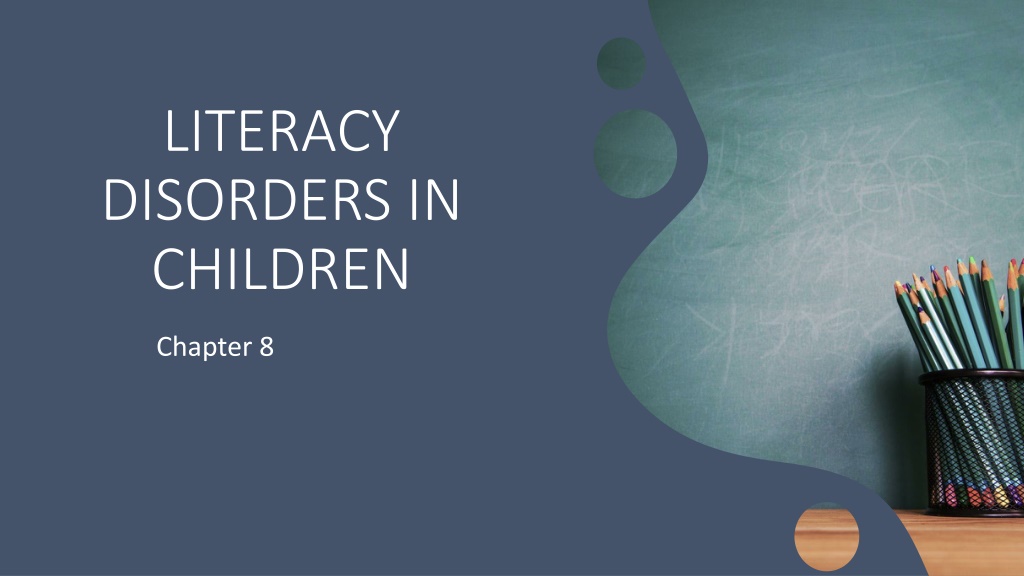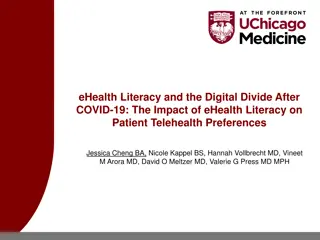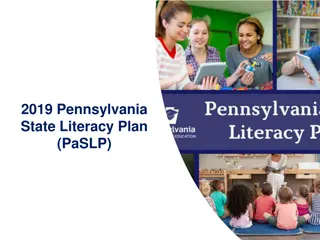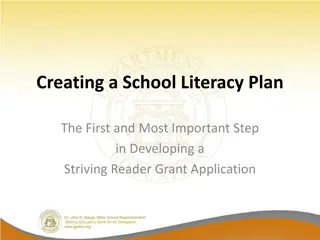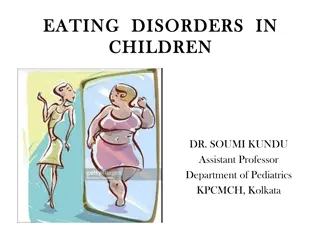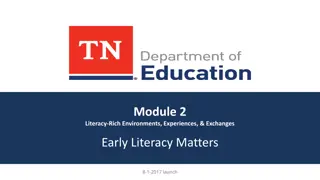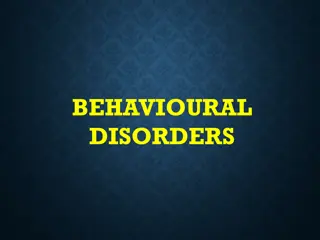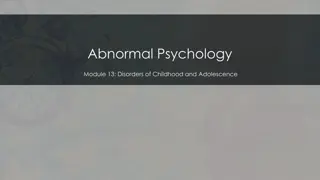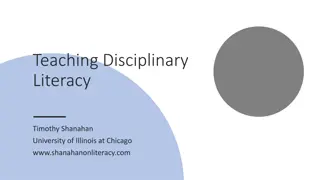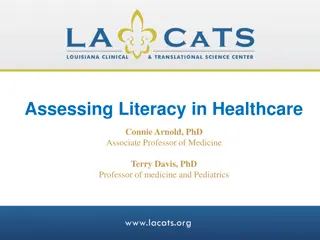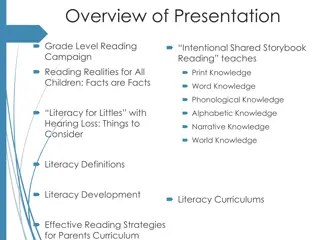Understanding Literacy Disorders in Children
Introduction to literacy disorders in children, covering the emergent literacy period, assessment, intervention strategies, and parental involvement. Discusses the roles of speech-language pathologists (SLPs) and resource specialists in addressing reading and writing challenges in educational settings. Emphasizes the importance of early language development and preliteracy skills. Explores the impact of technology, such as eBooks, on preschoolers' reading experiences.
Download Presentation

Please find below an Image/Link to download the presentation.
The content on the website is provided AS IS for your information and personal use only. It may not be sold, licensed, or shared on other websites without obtaining consent from the author. Download presentation by click this link. If you encounter any issues during the download, it is possible that the publisher has removed the file from their server.
E N D
Presentation Transcript
LITERACY DISORDERS IN CHILDREN Chapter 8
Outline I. Introduction II. Emergent Literacy/Preliteracy Period (Birth-Kindergarten) III. Literacy Disorders in Children IV. Assessment of Reading and Writing V. Intervention for Reading and Writing Challenges VI. How Parents can Help at Home
I. INTRODUCTION** In public schools, SLPs generally work on literacy skills indirectly with students who are already on the speech caseload Resource specialists work with students whose PRIMARY disability is reading and writing challenges Universities and private clinics have more leeway
SLPs can be involved:** Prevention, esp. working with teachers and children s caregivers to promote literacy in the home (like my Love Talk Read book drive!
Experts remind us that:** The ability to talk is caught Reading and writing are taught I ve mentioned that Mark had outstanding verbal skills but steep deficits in reading and writing
II. EMERGENT LITERACY/PRELITERACY PERIOD (BIRTH- KINDERGARTEN)** Babies can look at and turn pages in a book Shared book reading helps children learn vocabulary and how narratives are constructed Some young children learn the alphabetic principle: words consist of discrete sounds represented by letters in print. Alphabetic principle: foundation of reading
Preliteracy skills most strongly related to reading achievement:
Print vs. eBooks for preschoolers** Premise The American Academy of Pediatricians clearly states little-no screen time for children from 0-2 years, except for video chatting with relatives Research shows that school-aged children may benefit from eBook advantages (e.g., dictionaries, highlighting key words) One study (p. 183) did find that children with developmental disabilities benefitted from inclusive shared reading with eBooks
But.** What is their effect on dialogic reading and children s comprehension? Dialogic reading: interactive reading between caregivers and children
Disadvantages: (Willoughby, Evans, & Nowak http://www.eetconference.org/wp-content- uploads/
Parrish-Morris, Mahajan, Hirsh-Pasek, Golinkoff, & Collins. Once upon a time: Parent-child dialogue and storybook reading in the electronic era. Mind, Brain, and Education. ** Studied 165 parent-child dyads reading e-books and traditional paper books Children s story comprehension and parent-child dialogic reading were negatively affected by the presence of electronic features
ASHA Leader:** Cited a study done at University of Michigan Children s Hospital bit.ly/print-books
ASHA Leader** Recorded videos of parents reading to toddlers in 3 conditions: 1. Basic e-book (no sound effects or hot spots) 2. Enhanced e-books (e.g., with sound, animation) 3. Print books
ASHA Leader articleNumber of childrens verbalizations during reading
Dr. Perri Klass: Journal of the American Medical Association, parents and ch 10-16 months of age
Proficient Word Recognition** Children need to use direct, visual route to access words They especially need to read basic sight words fluently and automatically
We Can Teach Basic Sight Words** (not on exam) The of and a To in you is That it at he For on are as With his they be
** I use index cards and write the words down, one word per index card. When students can read the words quickly and with automaticity, reading comprehension and fluency are greatly enhanced!
In this video, I work with Miss Celestes Magic Words to improve sight word fluency Youtube Celeste Roseberry (Love Talk Read) How to Improve Reading Fluency Through Sight Word Drill and Sentence Formulation
Phonological awareness (PA): ** Knowledge of sounds and syllables and sound structure of words PA skills are essential to good reading; PA skills best predictor of reading and spelling in elementary school
By 3rdgrade (8 years old):** Children reach conventional literacy They can read and write and are able to read and write to learn Ideally they can automatically read many words and figure out new words through sounding them out If these processes are automatic, children can focus on comprehension
III. LITERACY DISORDERS IN CHILDREN** A. Introduction Children with literacy disorders frequently experience anxiety They may also be angry and take it out on those around them Possible depression and behavior problems Ernesto in second grade: I can t read, but I m trying to learn.
In terms of literacy disorders:** Dyslexia refers to a reading disability it s the most common learning disability in children and adults It is usually based on phonological processing deficits Ear infections can contribute Dysgraphia is a writing disability writing is often illegible; spelling problems are common
IV. ASSESSMENT OF READING AND WRITING** We as SLPs generally do not do this In the schools, done by a psychologist and resource specialist We can evaluate phonological awareness and refer out if needed I often dictate words and/or sentences and refer if I think there may be writing problems
V. INTERVENTION FOR READING AND WRITING CHALLENGES** In the schools, done by the Resource Specialist I try to incorporate writing into most of my therapy sessions Using a whiteboard and having kids copy really helps I also use sentence strips
In this video I use an eBook to draw Angelo s attention to print
Outline I. Introduction II. Emergent Literacy/Preliteracy Period (Birth-Kindergarten) III. Literacy Disorders in Children IV. Assessment of Reading and Writing V. Intervention for Reading and Writing Challenges VI. How Parents can Help at Home
